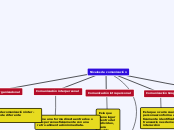TRASTORNOS DEL
LENGUAJE
Type in the name of the book you have read.
Trastornos psicolingüísticos
Type the main events of the book, classifying them in: events from the beginning, events from the middle, and events from the end of the book.
Describe the story visually. Add a representative picture for each of them.
Mutismo selectivo
No se debe a retraso, defectos de fluidez ni a problemas de comprensión
Incapacidad para hablar en situaciones especificas, donde se esperaba que lo hiciera
Type the main events from the end.
Add a representative picture for each of them.
T. de la comunicación
social o pragmático
Con frecuencia se asocia a un trastorno del desarrollo de
la coordinación
deficiencias en
el uso de la comunicación para propósitos sociales
Type the main events from the middle.
Add a representative picture for each of them.
T. del espectro
del autismo
Dificultad en la comunicación e interacción social
Type the main events from the beginning.
Add a representative picture for each of them.
Afasias adquiridas en la niñez
In contrast to the main idea, the theme is the message, lesson or moral of the book.
Some tips to find out the theme of the book easier:
- Try to find it while you are reading. It may be stated or implied.
- Think about how the characters reacted to obstacles.
- Think about the important decisions that the characters made.
- Think about the characters growing or changing throughout the book.
Perdida o retraso del lenguaje después
de desarrollarlo
Trastornos específicos del
desarrollo del lenguaje
Especifico
no depende de un déficit sensorial, neuromotor, cognitivo o socioemocional, sino que es un problema intrínseco del procesamiento del lenguaje
presentan dificultades para la adquisición y manejo de las habilidades de descodificación y codificación del sistema lingüístico
Take notes while you read the book. Write here your favorite quotes from the book.
Trastornos del ritmo
y de la fluencia
Take notes while you read the book. Type here the resources, books, or websites that the author mentioned and you want to check out later.
El tartamudeo o espasmofemia
Bloqueos y repeticiones de una o
varias sílabas acompañados de movimientos de laguna parte del cuerpo
El farfulleo taquilálico
habla rápida, atropellada y
de difícil inteligibilidad
Dislalia
Sin defectos anatómicos, motores o
neurolingüísticos subyacentes
alteraciones en la expresión
sonora de fonemas
The main idea is what the book is mostly about.
Some tips to find out the main idea of a book easier:
- Read the title.
- Look for the text features.
- Figure out if you are reading a fiction or a non fiction book.
- Think about some examples that support this idea.
Déficit auditivo
Type the names of the book characters. Start with the main character.
Draw arrows to represent the relationship between them and if it is possible write on them what they represent for each other (if they are relatives, friends, lovers, enemies etc.)
principal causa orgánica
del trastorno del lenguaje
Dislosias
What is the reason why the author wrote the book?
En el tratamiento
ortodoncia, cirugía maxilofacial y terapia logopédica, que se adaptará al calendario quirúrgico y de desarrollo del niño
alteraciones articulatorias debidas a anomalías anatómicas de los órganos articulatorios
Disartrias
Who is the author of the book? Type in his/her name.
Anomalías de pronunciación
Causados por afecciones nervios craneales o de los grupos musculares de la zona bucofaringo-laríngea
La incontinencia salival o babeo









